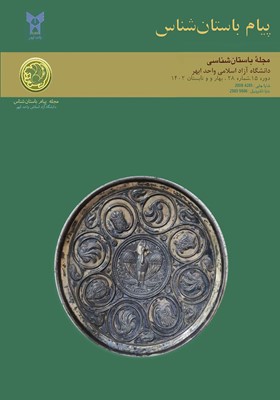اصالتسنجی بشقابهای نقره ساسانی بر مبنای بررسیهای فنشناسی و آسیبشناسی
محورهای موضوعی : باستانشناسی تاریخیمعصومه یوسفی 1 * , سید علی اصغر میرفتاح 2 , فرزاد مافی 3
1 - دانشجوی دکتری باستانشناسی، گروه باستانشناسی، دانشگاه آزاد اسلامی، واحد ابهر، ابهر، ایران.
2 - استادیار، گروه باستانشناسی، دانشگاه آزاد اسلامی واحد ابهر، ابهر، ایران.
3 - استادیار، گروه باستانشناسی، دانشگاه آزاد اسلامی واحد ابهر، ابهر، ایران.
کلید واژه:
چکیده مقاله :
تعیین اصالت اشیاء باستانی یکی از موضوعات مهم در حوزه میراث فرهنگی است که با توجه به متنوعتر شدن شیوههای جعل، پژوهشگران را بهسوی استفاده از روشهای کاربردیتر برای تشخیص اصالت آثار سوق میدهد. بشقابهای نقرة ساسانی از جمله اشیایی هستند که به دلیل آشکارساختن برخی ویژگیهای فرهنگی و هنری دورة ساسانی، از اهمیت ویژهای برخوردار هستند. تاکنون تشخیص اصالت این بشقابها بیشتر مبتنی بر ریختشناسی و تبیین نقوش بوده است که با توجه به سهولت ایجاد نقشمایههای این دوره، شیوة مزبور برای شناسایی بشقابهای جعلی کافی نبوده و نیاز به روشهای تکمیلی وجود دارد. هدف از این پژوهش، یافتن پاسخی برای این پرسش است که آیا تشخیص اصالت اثر میتواند بر مبنای شناسایی تکنیکهای ساخت و تزئین و تشخیص آسیبهای وارد شده به شیء انجام گیرد؟ به این منظور، تعداد ۵۰ عدد بشقاب نقره ساسانی در موزههای رضا عباسی، میهو، متروپولیتن، ارمیتاژ و موزه بریتانیا مورد مطالعات فنشناسی و آسیبشناسی قرار گرفته است. نتایج نشان میدهد که آنالیز نقره مورد استفاده، مقایسة غلظت عناصر با نمونة اصلی و تکنیک طلاکاری جیوهای در بخش فنشناسی و خوردگیهای دو فلزی با ویژگیهای خاص و مشاهدة خوردگیهای رشتهای در بخش آسیبشناسی نیز میتوانند در کنار اصالت فرم و نقش، در تشخیص اصالت این قبیل آثار راهگشا باشند.
Determining the authenticity of ancient artifacts is one of the important issues in the field of cultural heritage, which, due to the diversification of forgery methods, leads researchers to use more practical methods to determine the authenticity of cultural artifacts. Sassanid silver plates are among the objects that are of special importance because they reveal some cultural and artistic features of the Sassanid period. Until now, the identification of the authenticity of these plates has been mostly based on morphology and explanation of motifs. Considering the ease of creating motifs of this period, the mentioned method is not enough to identify fake plates and there is a need for additional methods. The research question is whether it is possible to find out the authenticity of a cultural artifact based on the identification of the construction and decoration techniques and the damage caused to the object. To address this research, a comprehensive investigation has been conducted on a sample set comprising 50 Sassanid silver plates sourced from prominent museum collections including the Reza Abbasi, Miho, Metropolitan, Hermitage, and British Museums. This investigation encompasses both technical analyses and pathological examinations. The results show that silver analysis, comparing the concentration of elements with the original sample and the technique of mercury gilding, as well as bimetallic corrosion with special characteristics and observation of filamentous corrosion can help recognize the authenticity of such artifacts in addition to the originality of the form and motif.

